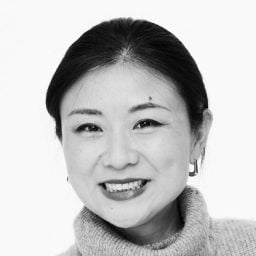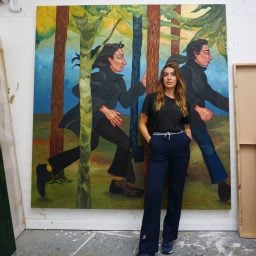Ascending a dim, narrow staircase—sometimes navigating around artists carrying canvases—and through a weighty metal door, I enter the studio of Li Hei Di (b. 1997). By London standards, her studio feels spacious. Its walls play host to her expansive artworks, many yet unfinished. Ethereal figures appear submerged in shallow waters within these canvases but are only visible when I pause long enough to see them. The figures, bathed in a glow of soft fluorescent lights, are mythical and cinematic at once.
In some sense, the door to the artist’s studio connects two worlds. Nestled in Ridley Road Market in Dalston, the ambiance outside her studio building is a cacophony of fabric shop peddlers and the distinct aroma emanating from butcher stores. For Li, this is not the typical London, but rather it evokes memories of her hometown. Born in Shenyang, a major city in northeastern China, Li moved abroad in her teenage years, and yet remains anchored to her cultural origins, preserving them most vividly in her visual memory of sound and image.
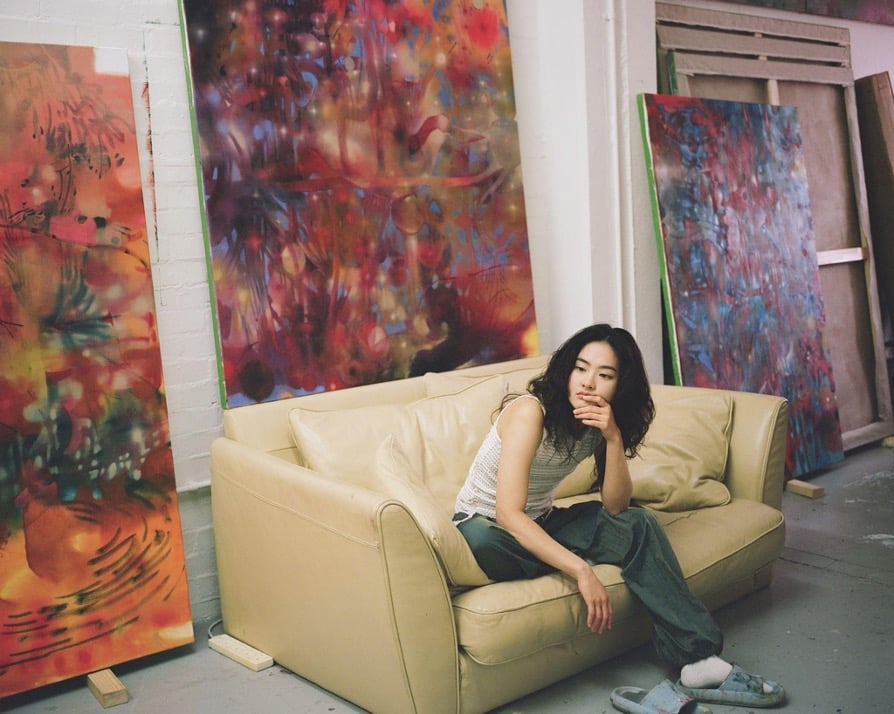
Li Hei Di in her London studio. Images courtesy of the artist and Michael Kohn Gallery. Photography by Kai Shui
Li shows me a compilation of collages she has collected and amassed over the years—a “book of inspirations.” The content of this compilation is mostly screenshots from Hong Kong movies, predominately from the late 80s and early 90s, marking the twilight of its golden era. Iconic films like A Chinese Ghost Story, Green Snake, and Swordsman II showcase women protagonists. Li is candid about her fascination with these on-screen women figures who embody subtle feminism: they are active rather than passive, and they are rebellious yet never overtly so. These women often defy gender norms, blending the feminine and masculine, occupying a state of fluid ambiguity. These themes appear in Li’s recent work, too. Engaging the viewers in a visual interplay, in these canvases the bodies are obscured but never entirely hidden or masked. The oil paint mimics drenching, pools of water, creating translucence around and over these figures, making them appear as though they’re perpetually in motion in a way reminiscent of Li’s collages. For the artist, painting is narrating, akin to “composing a novel visually.”
Before earning her MA in Painting from the Royal College of Art, Li Hei Di received BAs from both the Chelsea College of Arts and the Maryland Institute College of Art. Her entry into the art world was swift; she quickly garnered recognition through her inclusion in a variety of group exhibitions spanning both sides of the Pacific and Atlantic Oceans. Notably, her work was featured in “Uncanny Valley” at Gagosian Hong Kong this past January. Currently, Li is immersed in the creation of her latest series, which is slated for unveiling at her U.S. solo debut. at the Michael Kohn Gallery in Los Angeles in November.
Ahead of the exhibition, we spoke to the artist about her fascination with torsos, her love of Miriam Cahn, and London’s incredibly competitive market for studios.
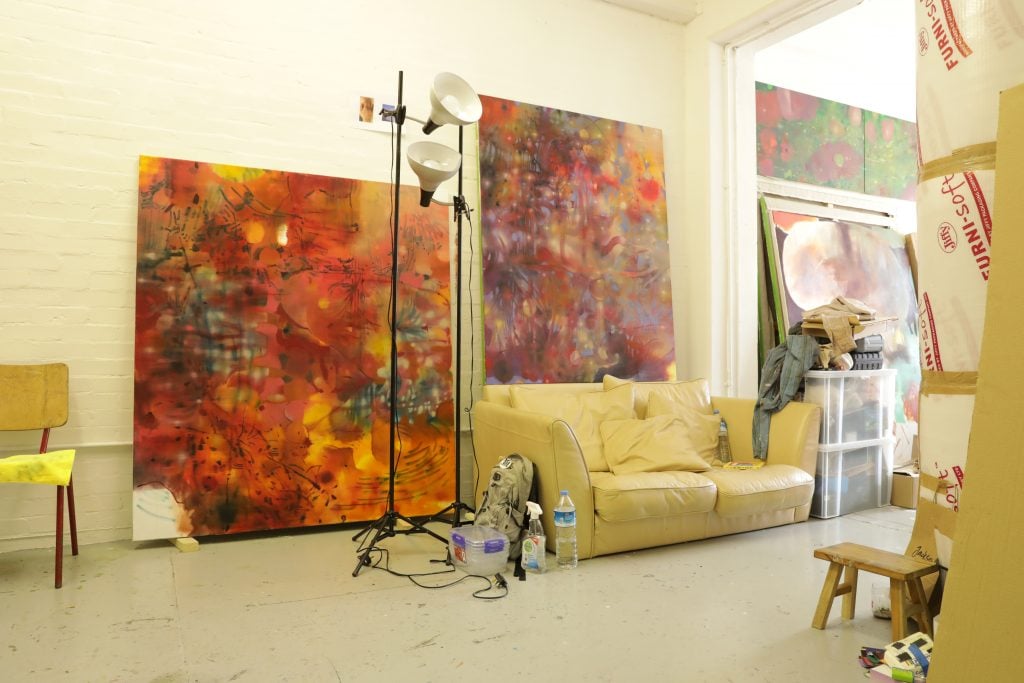
Li Hei Di’s London studio. Images courtesy of the artist and Michael Kohn Gallery. Photography by Kai Shui
Tell us about your new series of work in the upcoming Michael Kohn Gallery show. Have they been developed further from your previous work?
I feel like I have developed quite a lot from my previous works. The imagery in the new series of work has become more complex and there are more distinct figurative elements than before. The figures in my paintings are submerged in water or flooded by lights; they are ambitious, and it might take the viewer a second or two to really see the figures. The figures in my paintings are like ghosts, translucent beings, not solid humans, they are possibilities, not conclusions; they are forever in transition but not in a hurry to become someone. I think making figures in my work is like ghost-haunting in the abstract jungle of my mind.
When we met in your studio, you worked on four paintings simultaneously. Is this how you always paint? How could you work on multiple paintings without distracting each other?
I love working on several paintings at once, but sometimes I do get fixated on one work. I think I try to resist recycling the same images in my work because I’m easily bored, oftentimes the paintings I work on simultaneously are quite different from each other in color and style.
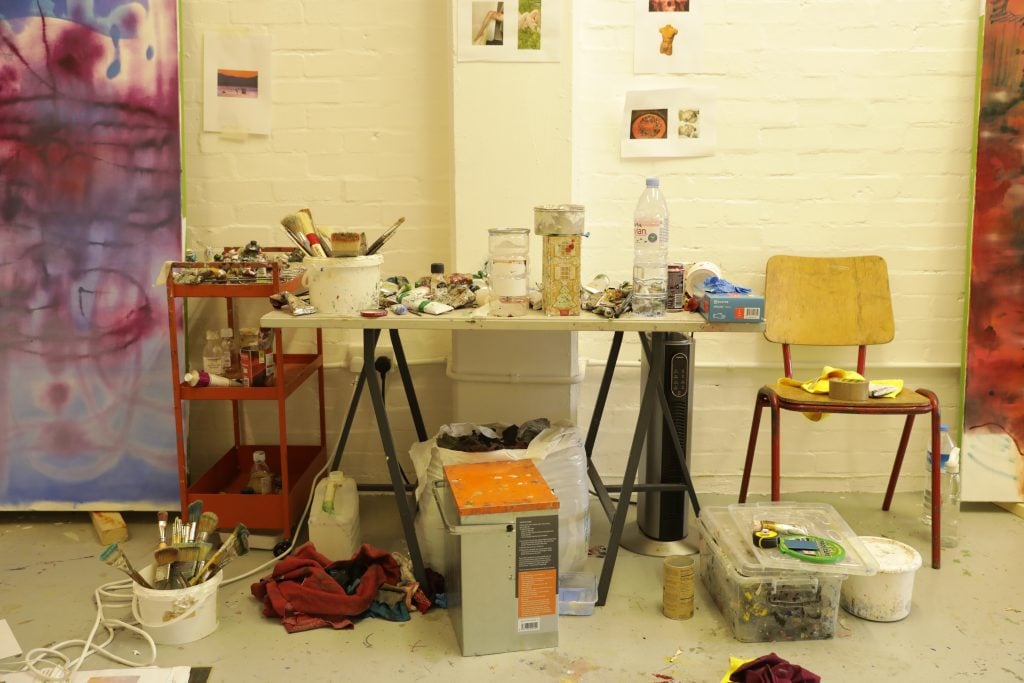
Painting supplies in Li Hei Di’s studio. Images courtesy of the artist and Michael Kohn Gallery. Photography by Kai Shui
Why do you get attracted to torsos?
I think torsos are like the second face of the body, nipples are the eyes, and the belly button is the mouth. Torsos are also the more intimate face of the body. When you put your face close to someone’s exposed chest, you are sharing an intimate moment with this person, not only because of the nakedness of that person but also because their heart is close to you. To bury your face in someone’s chest, you can almost see the landscape in their body; to be in love with someone, you can feel lights shining through their chest cavity, it surrounds you, and warms you. I want to capture that feeling of excitement to be so close to someone as well as the lands and lights I see within their chest.
Tell us about your studio. Where is it, how did you find it, what kind of space is it, etc.?
My studio is in Dalston, right at the Ridley Road Market. I have just moved into the area, I love the market, the fruits they sell here as well as the big fabric shops. It doesn’t feel like London, it feels more like a parallel universe of my grandpa’s village; it somehow feels more at home than the stereotypical London. I took the studio over from a friend, Nana Wolke, who previously worked there.
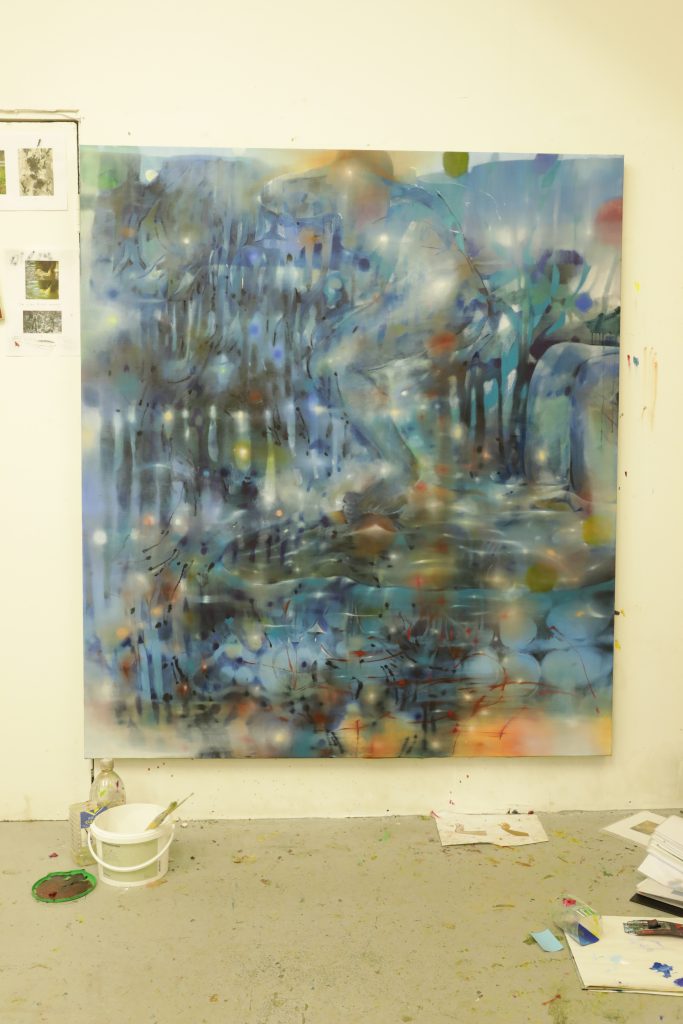
Li Hei Di’s London studio. Images courtesy of the artist and Michael Kohn Gallery. Photography by Kai Shui
What made you choose this particular studio over others?
There is no choice in London, you take what you get. The prices for renting a studio are skyrocketly high and there are barely any opinions. All the studio spaces have a long waiting list, I’m just happy I have a studio.
How many hours do you typically spend in the studio, what time of day do you feel most productive, and what activities fill the majority of that time?
I normally stay in the studio for at least 8 hours, 5 days per week. I go to the studio around 3 pm and start working at 4 pm and paint till around midnight or 1 or 2 am. I paint the majority of the time while I listen to audiobooks or call my friends. I sometimes slack off scrolling on my phone on my sofa.
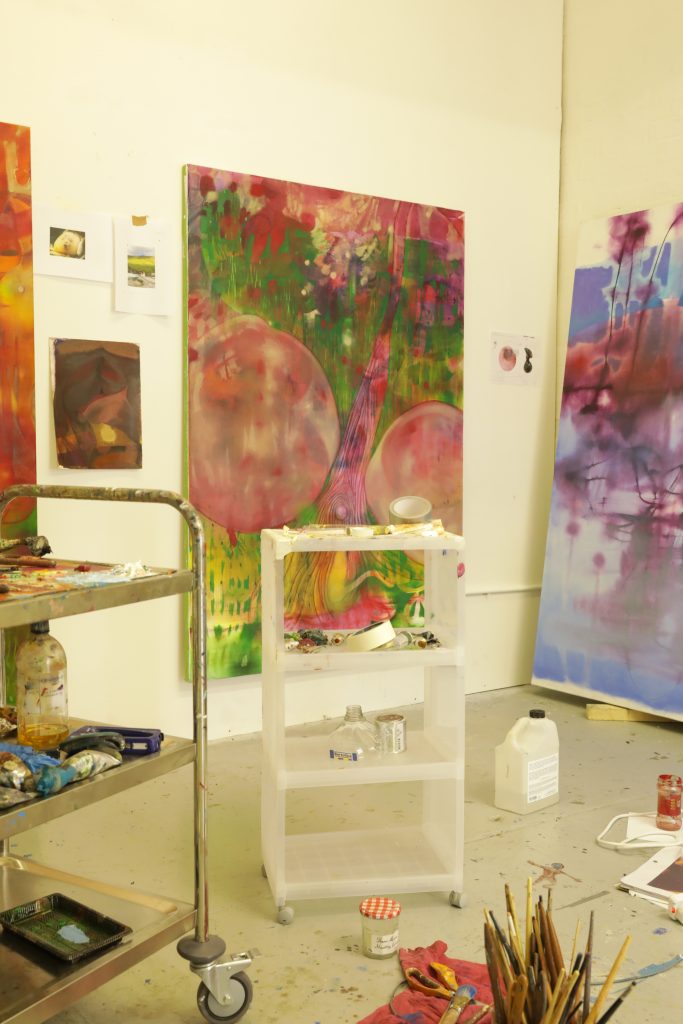
Painting supplies in Li Hei Di’s studio. Images courtesy of the artist and Michael Kohn Gallery. Photography by Kai Shui
When you feel stuck while preparing for a show, what do you do to get unstuck?
I normally take a day off and stay at home. The last time I got stuck and depressed from painting, I sought comfort from loved ones, read some poems by William Carlos Williams, and watched Lust and Caution. I also looked at old master paintings and reminded myself art is good, and to be patient.
What is the first thing you do when you walk into your studio (after turning on the lights)?
I sit on my beautiful sofa and eat some snacks.
What tool or art supply do you enjoy working with the most, and why?
I love my collection of jars that I use to put my mediums/solvents in, I collect all kinds of containers for painting, my favorite is my Lao Gan Ma jar.
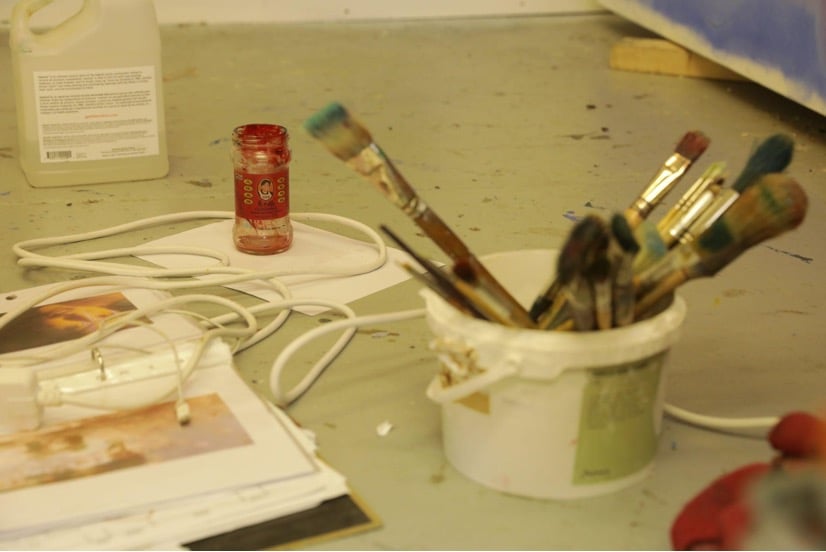
Painting supplies in Li Hei Di’s studio. Images courtesy of the artist and Michael Kohn Gallery. Photography by Kai Shui
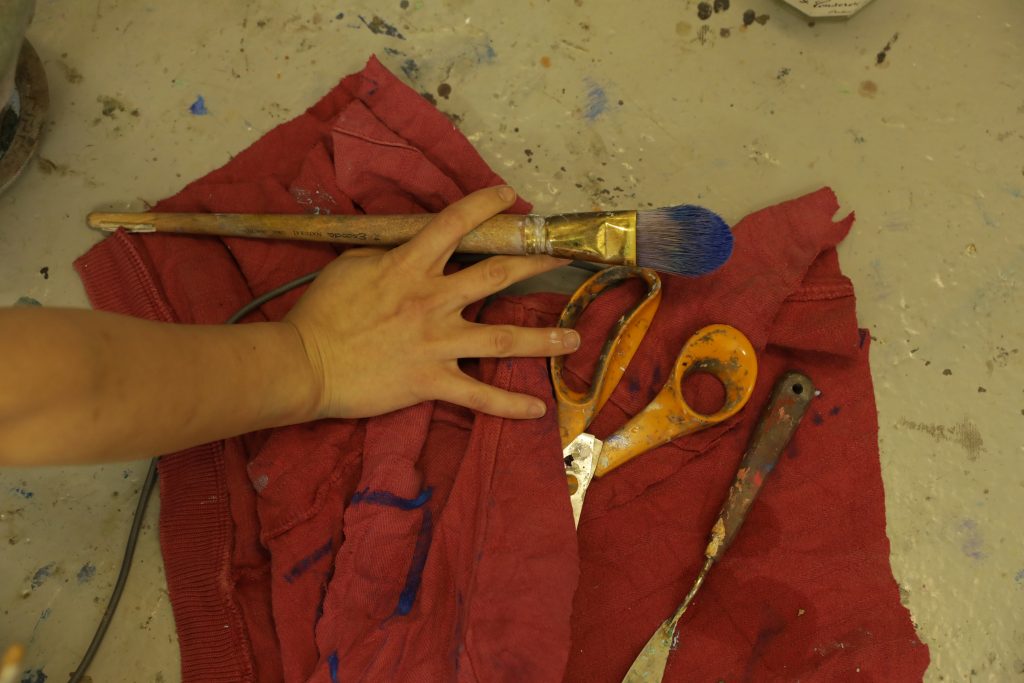
Painting supplies in Li Hei Di’s studio. Images courtesy of the artist and Michael Kohn Gallery. Photography by Kai Shui
Is there anything in your studio that a visitor might find surprising?
My explicit reference photos are on the walls.
What is the fanciest item in your studio? The most humble?
I have this rolling stool that’s made for barbers who sit for long hours, it was a bit expensive but it helps me sit straight while painting. The most humble item would be the brushes I have been using since college.
How does your studio environment influence the way you work?
My studio is like a separate universe from the real world. It only has a very small window that’s far from my main working space, so I feel like I’m a hermit crab, it really helps me to focus in my own little world but it does get lonely sometimes.
What’s the last museum exhibition or gallery show you saw that really affected you and why?
Miriam Cahn at Palais De Tokyo is easily my favorite exhibition of the year. I am obsessed with Cahn’s work, the effortlessness of the brushwork and the vibrant colors made my heart shiver. I also loved how they hung the show with small works surrounding larger paintings in salon style, it really took us into Cahn’s world. The show was intimate, raw, and ethereal.









